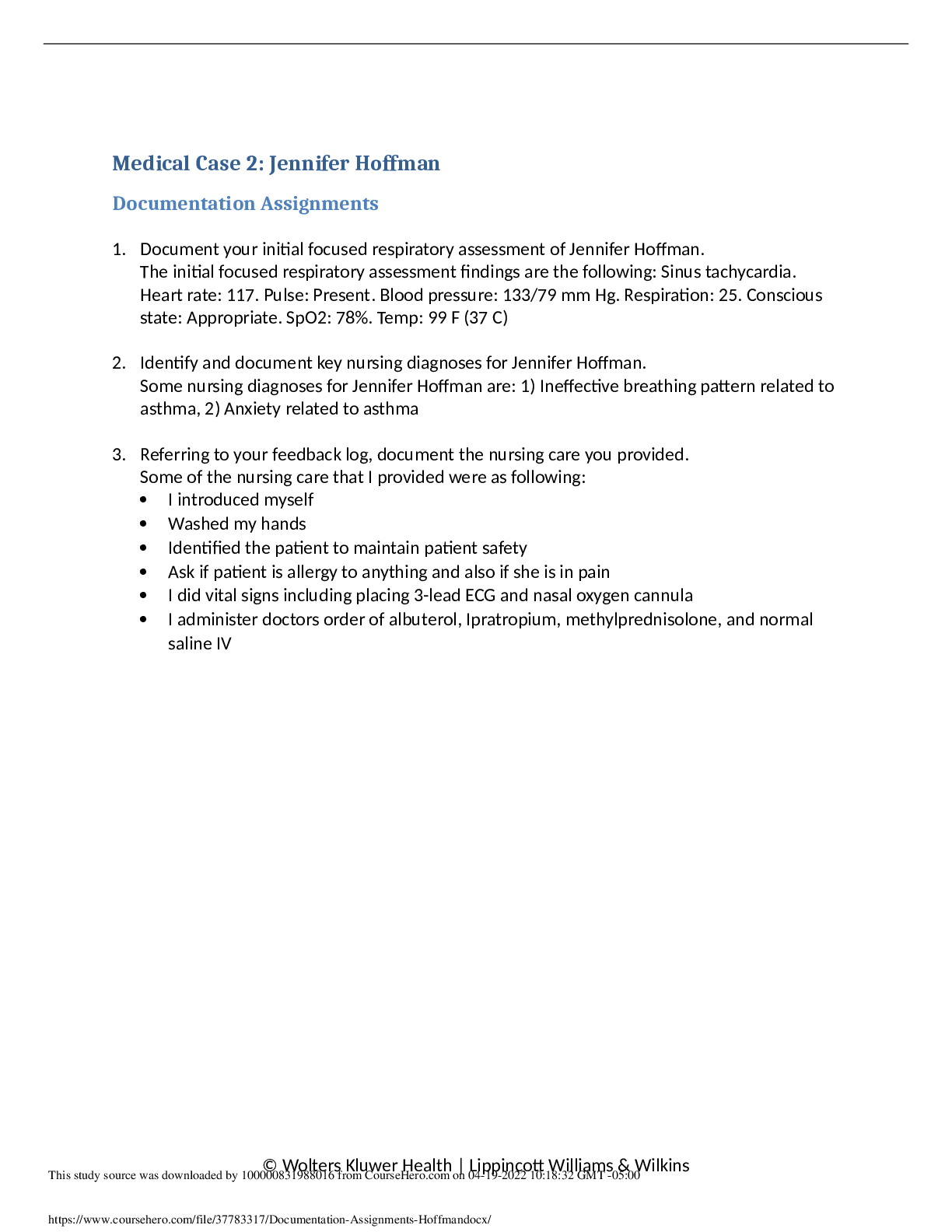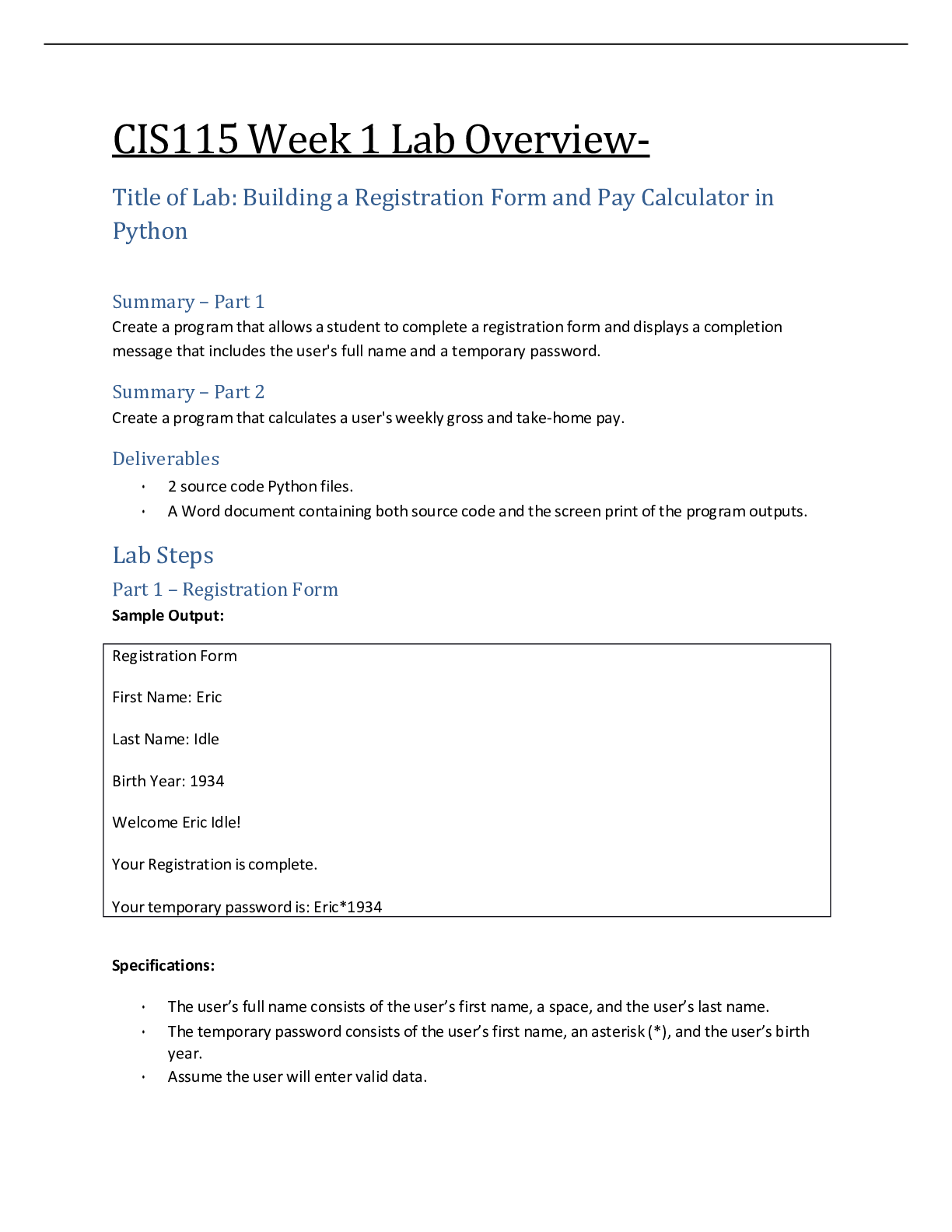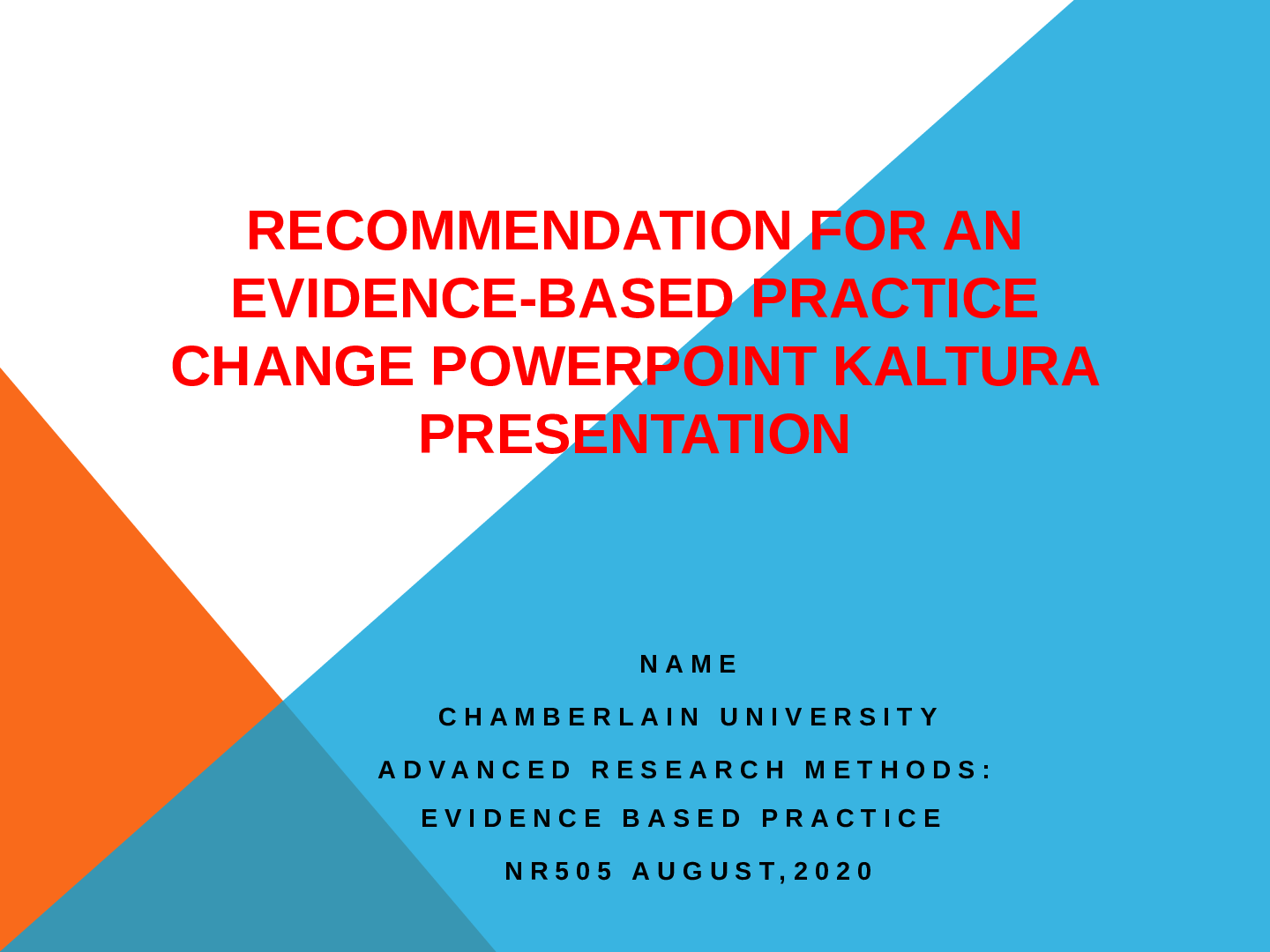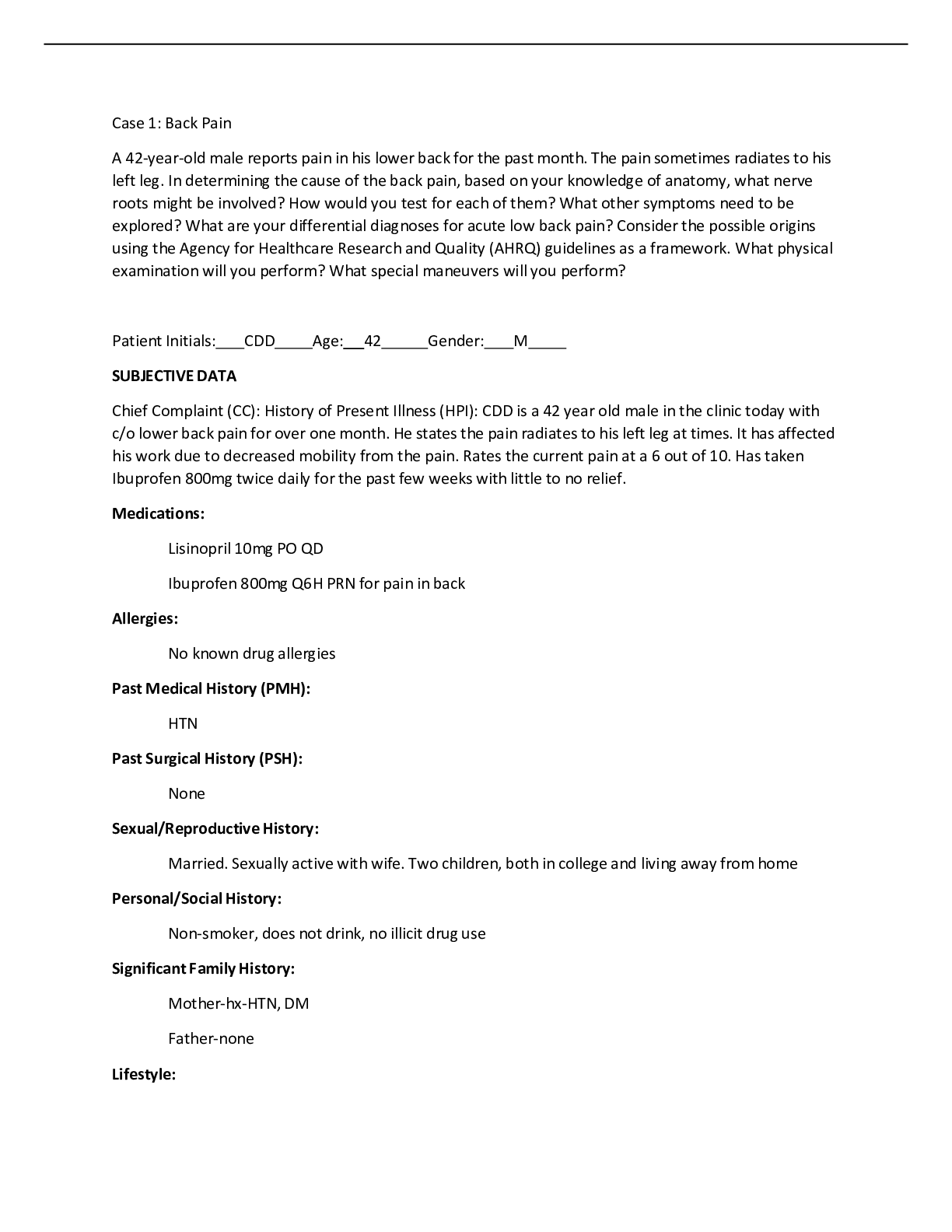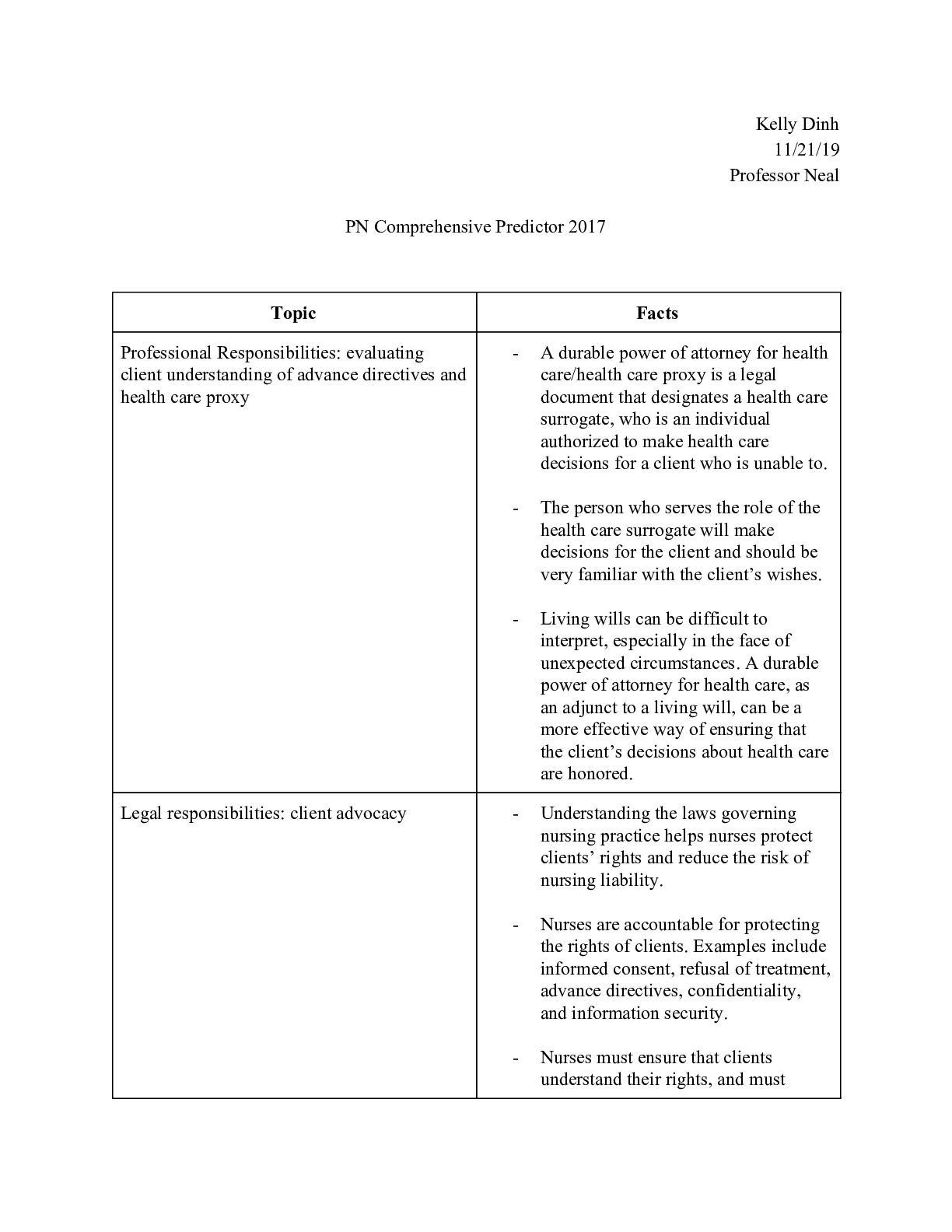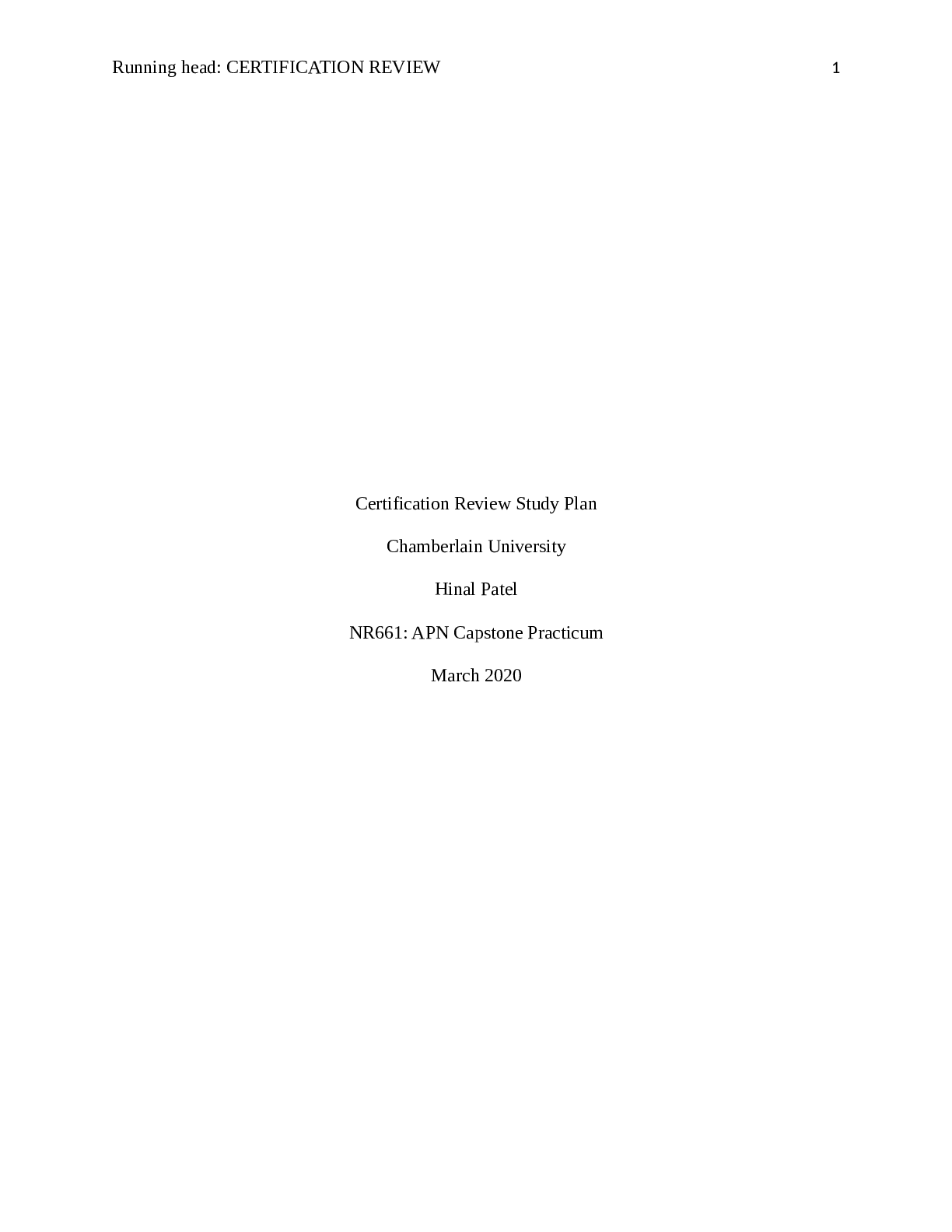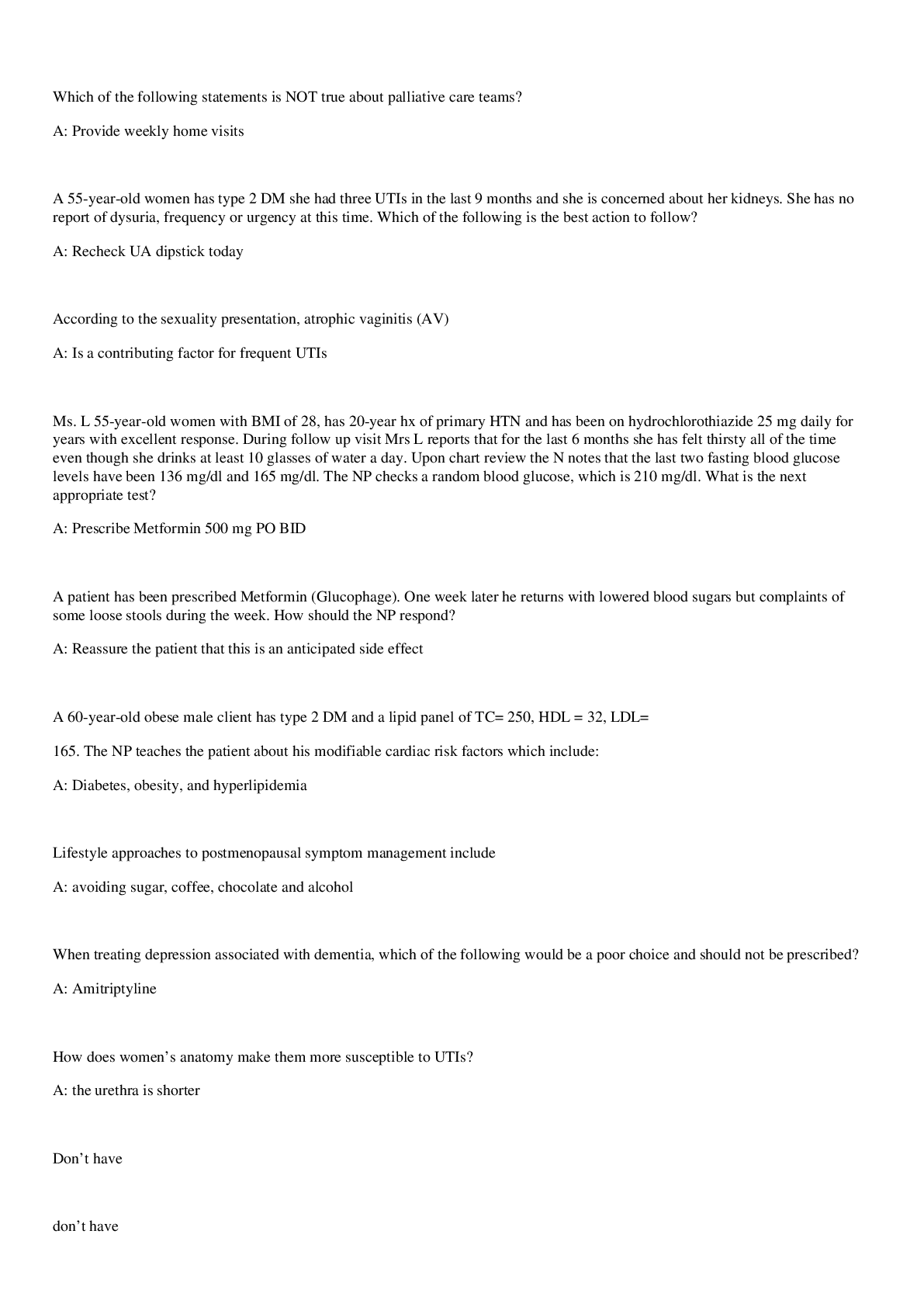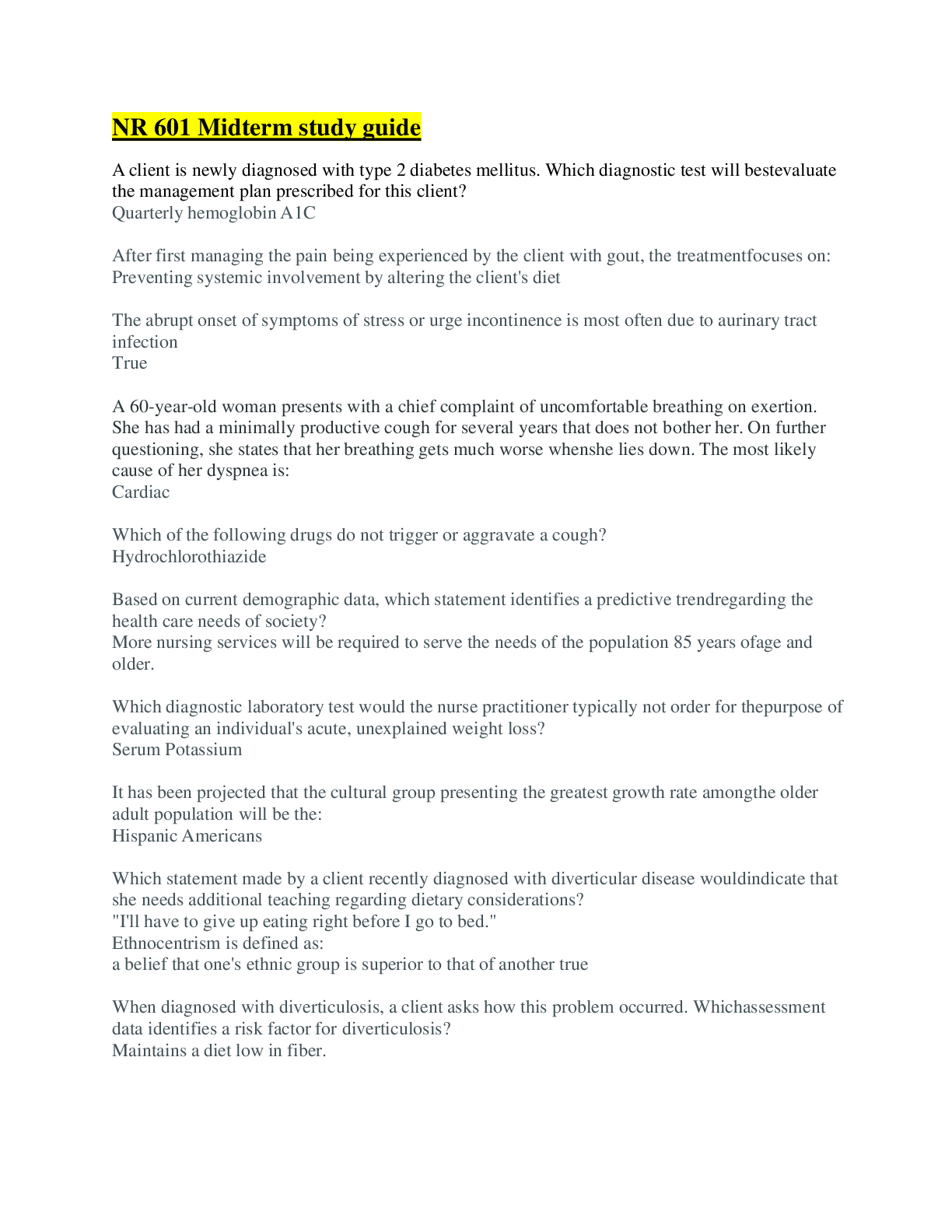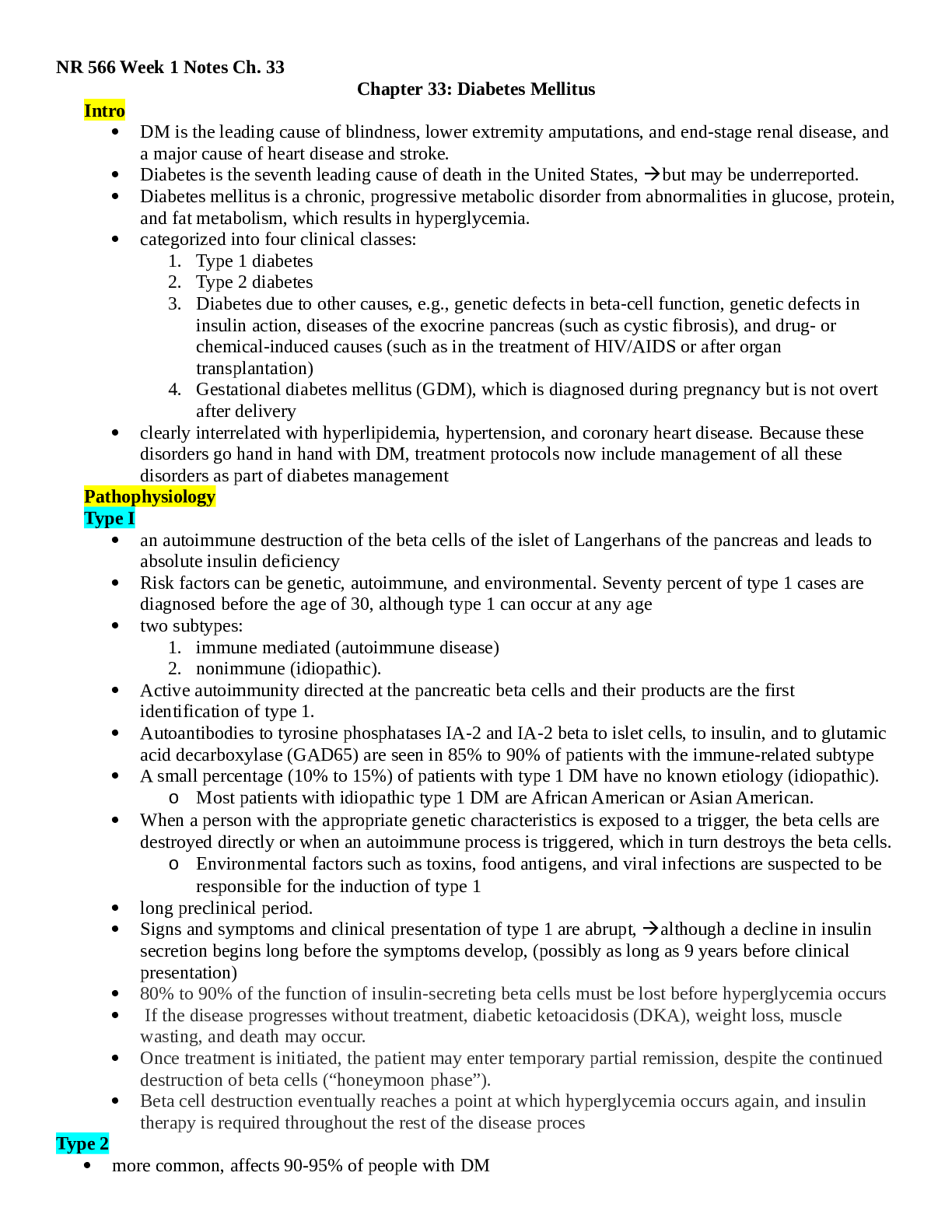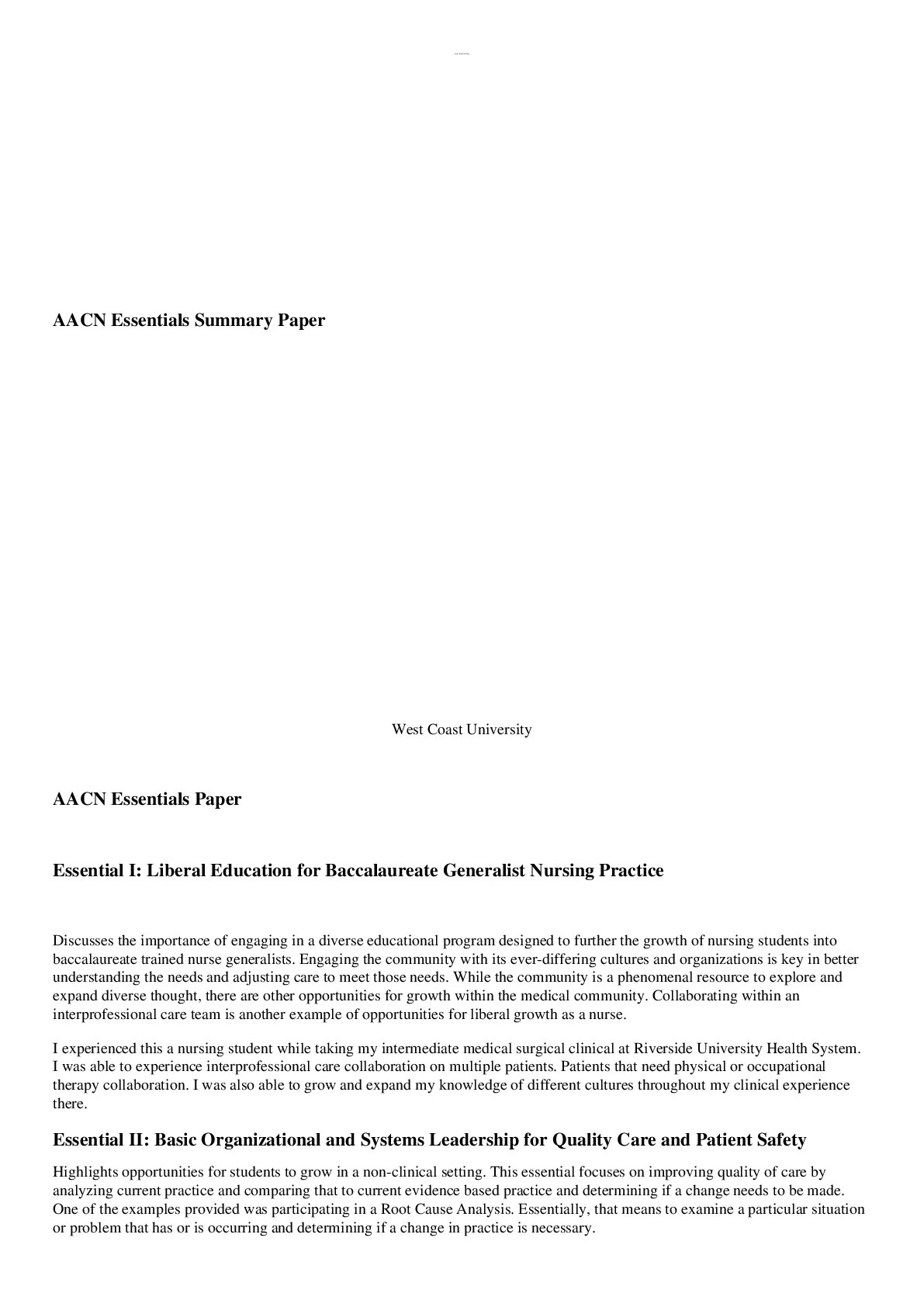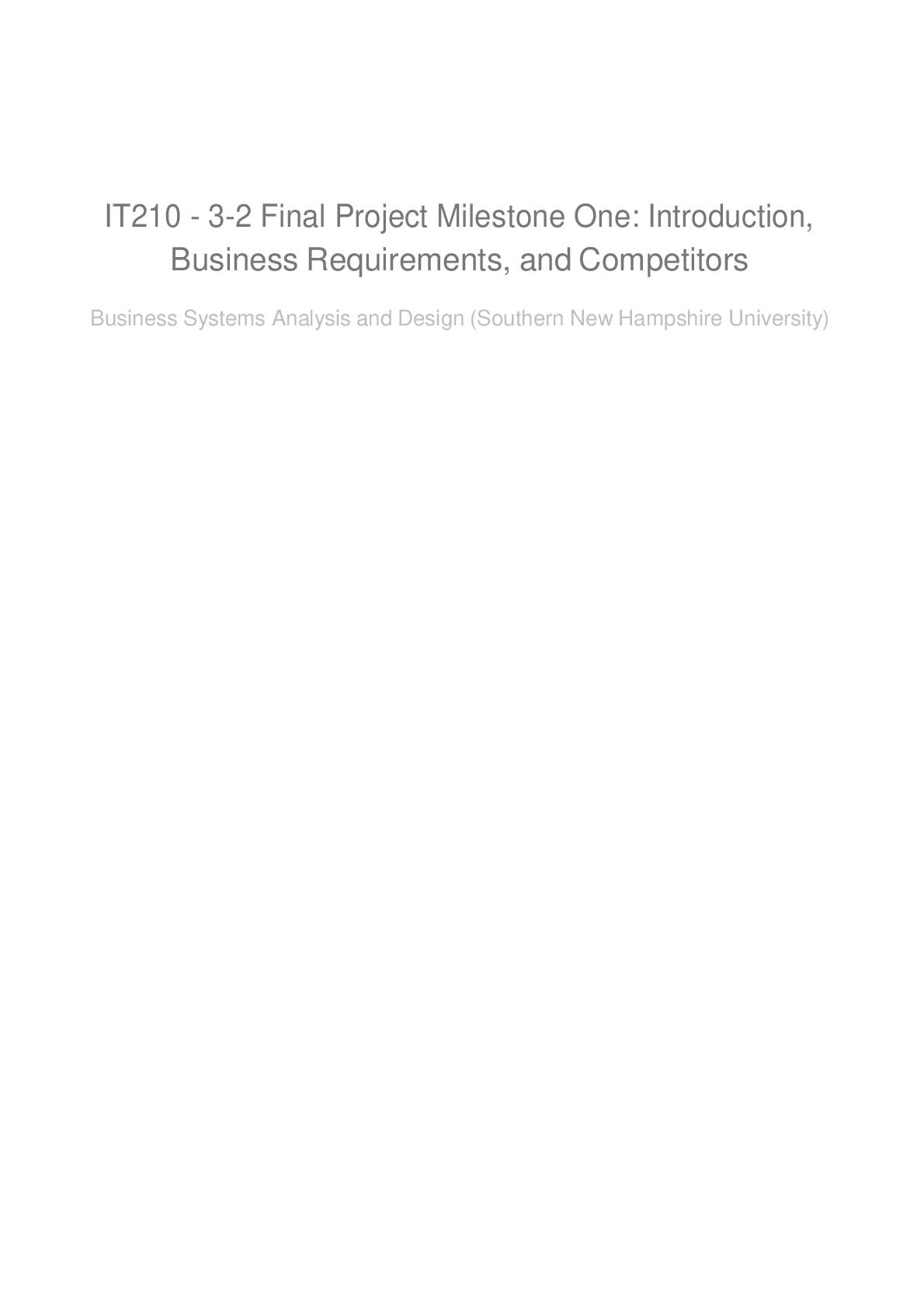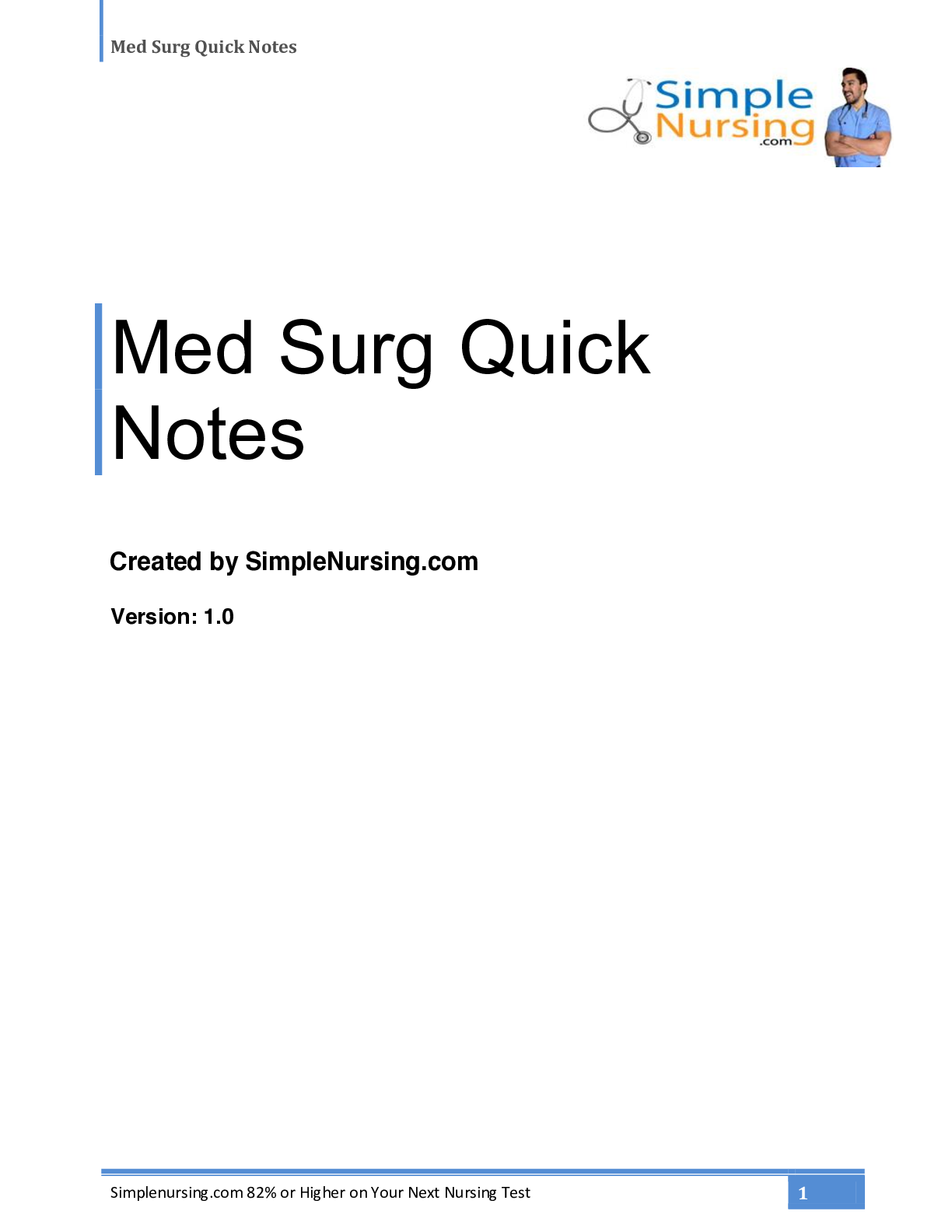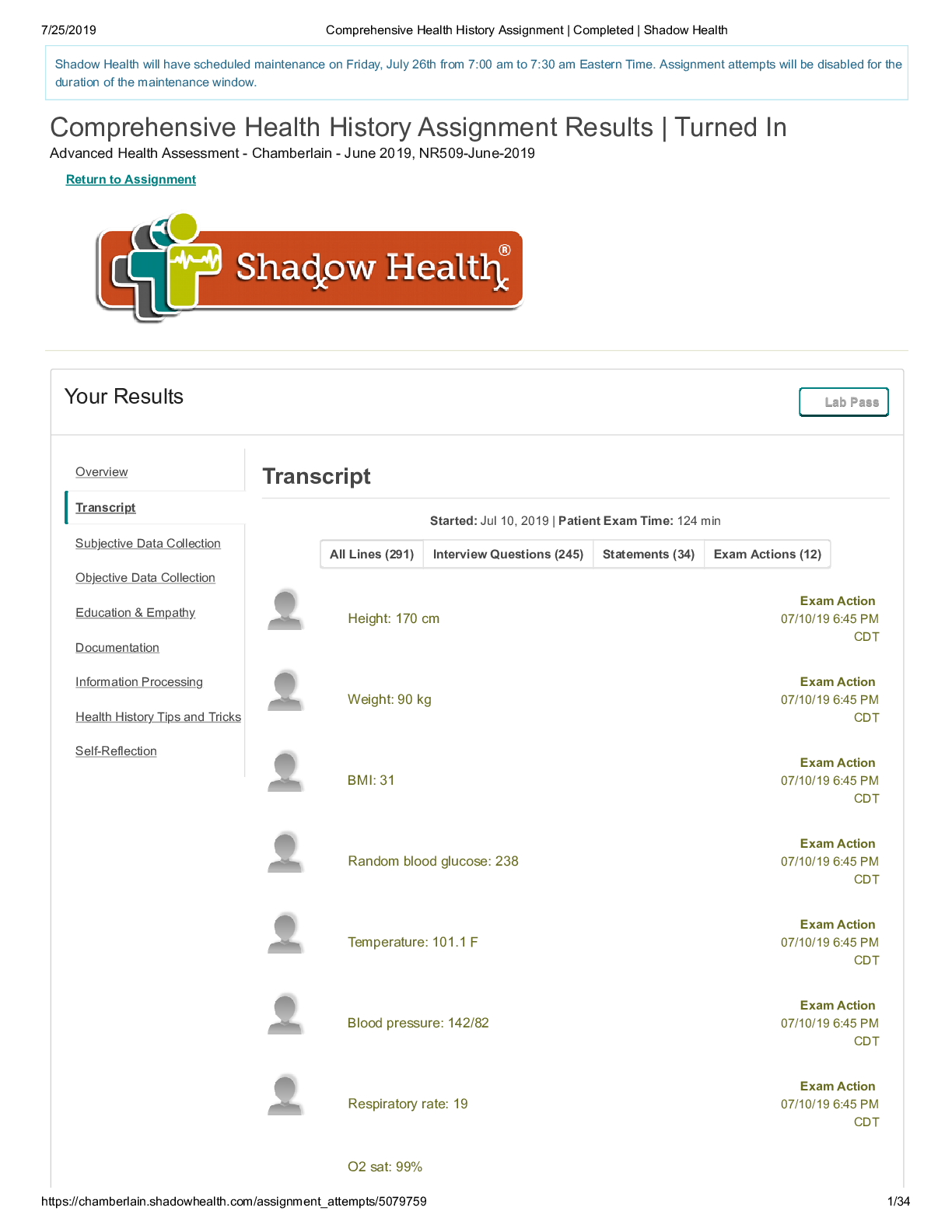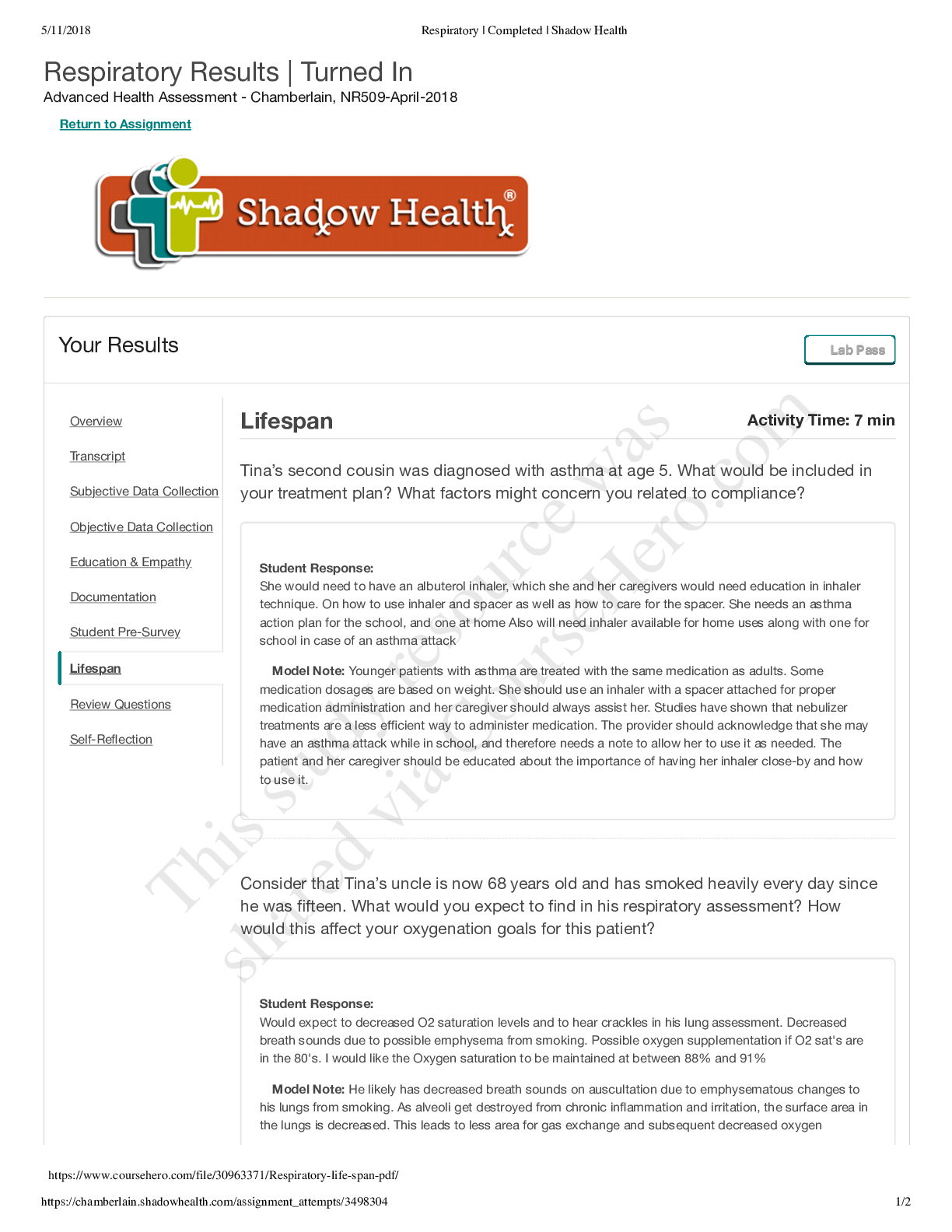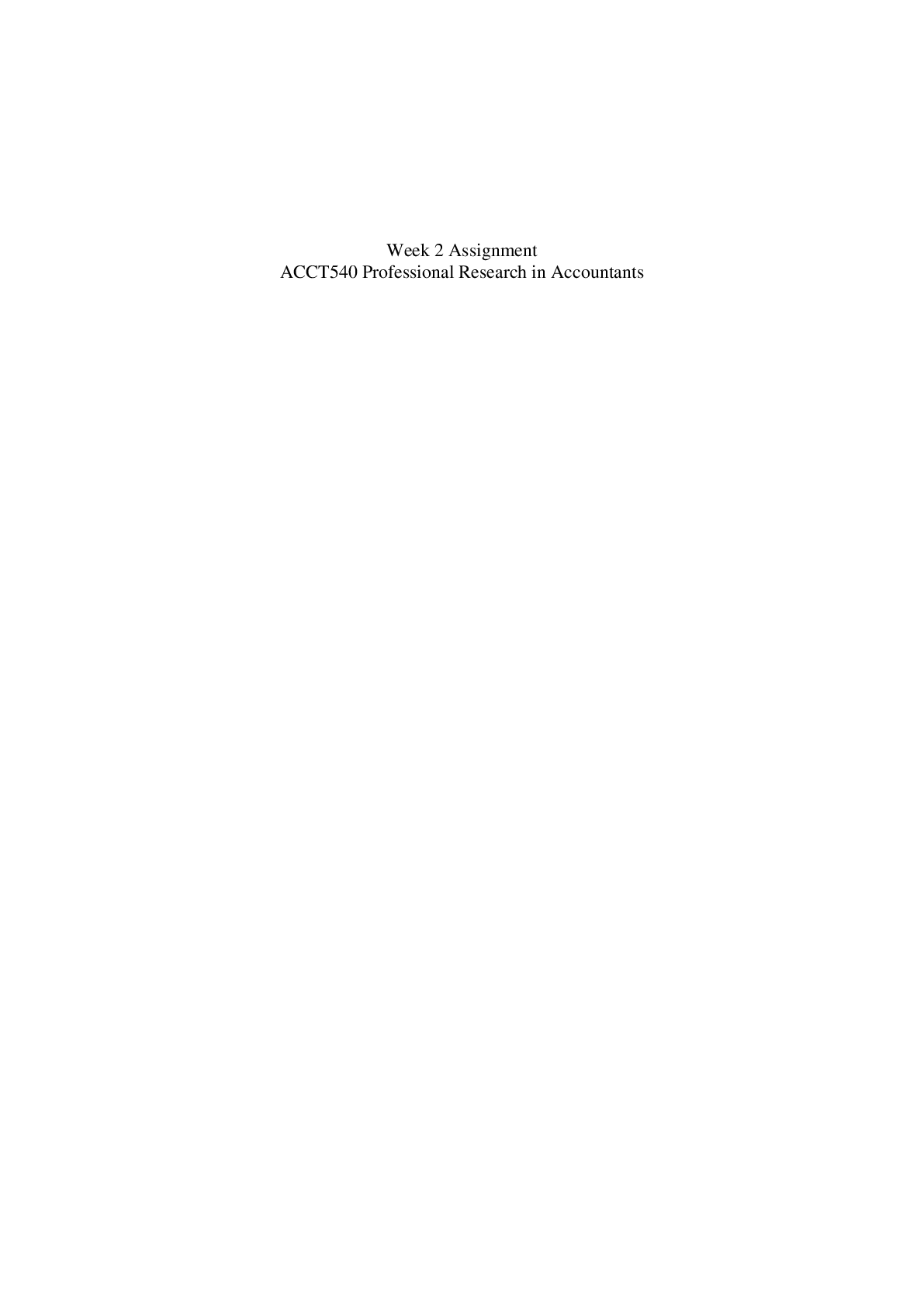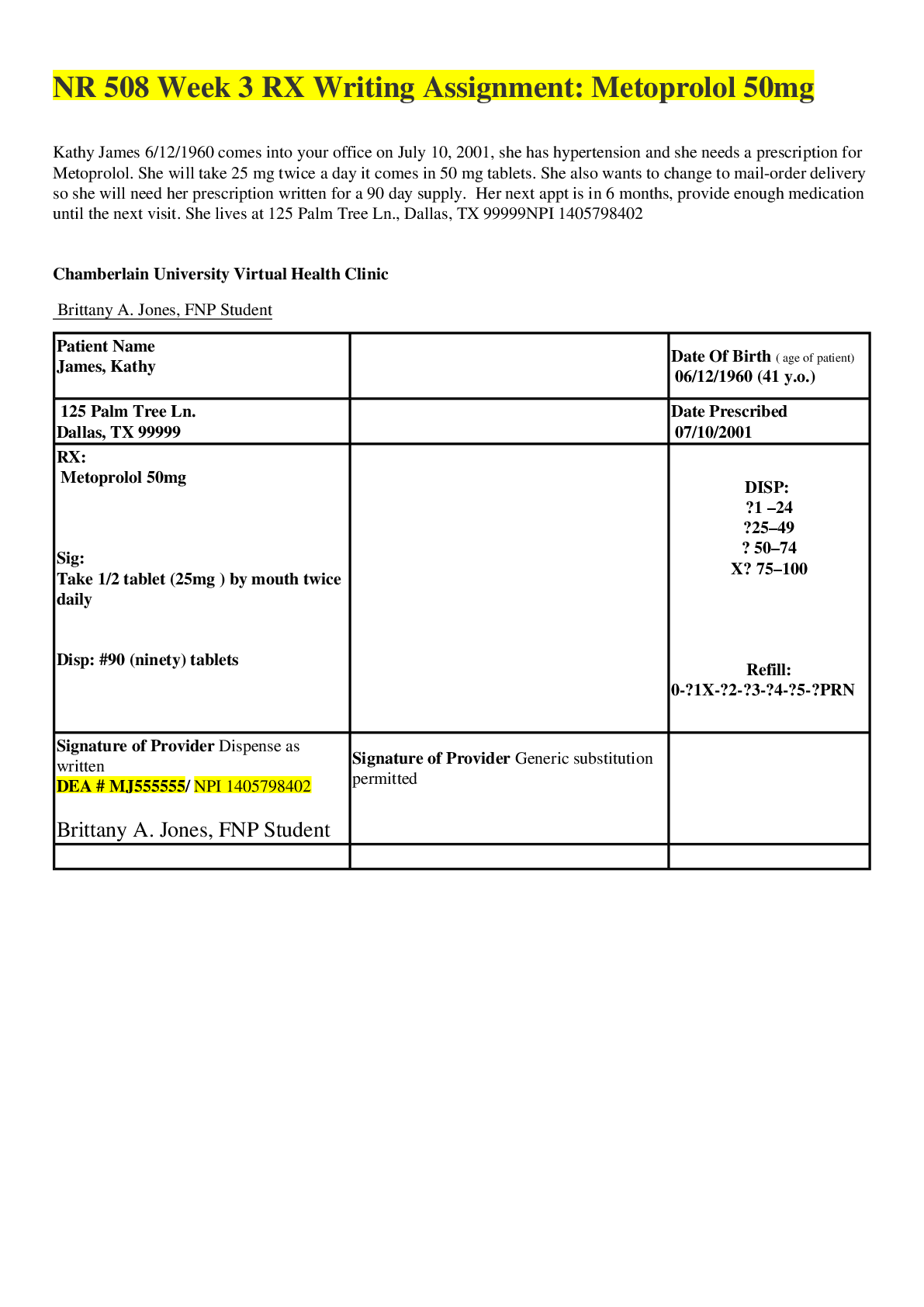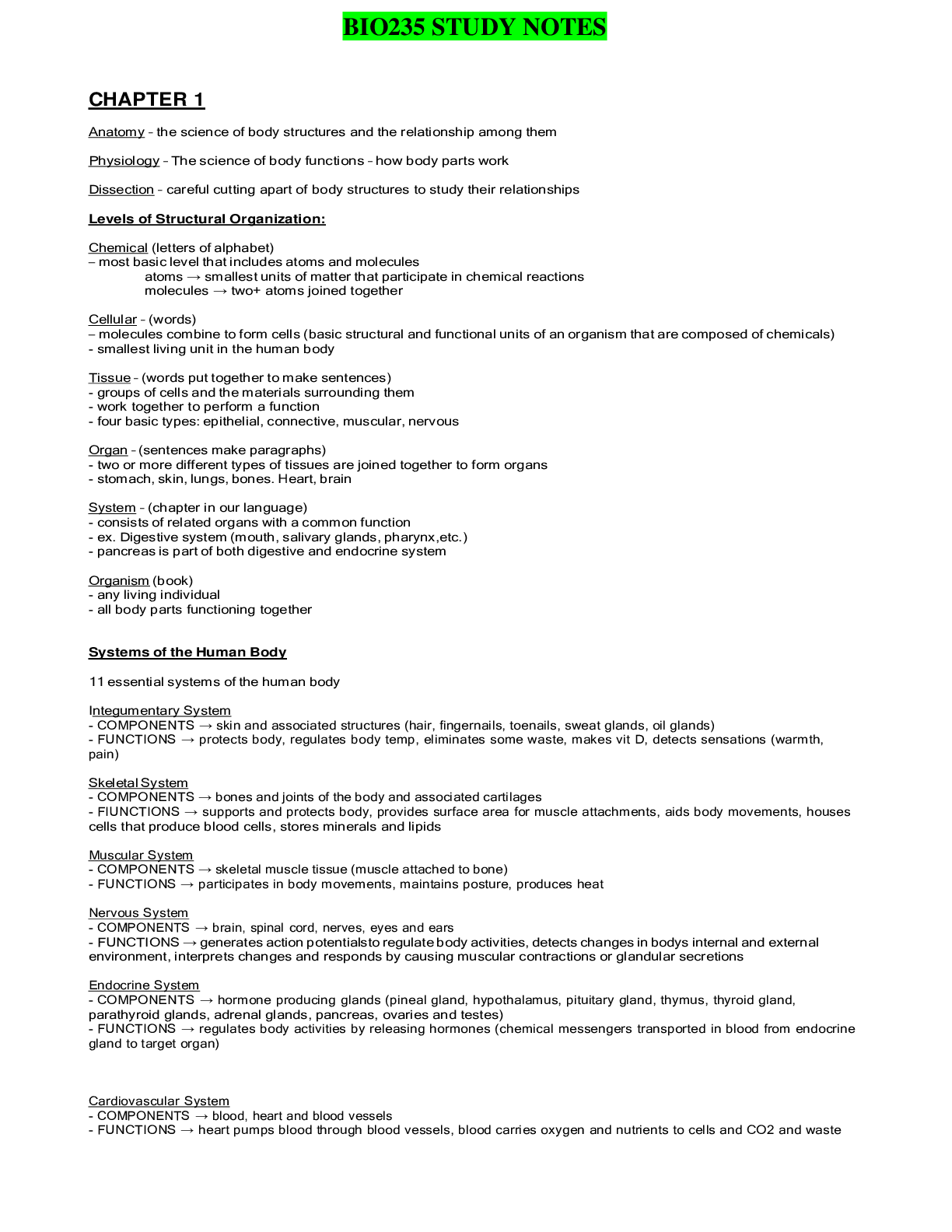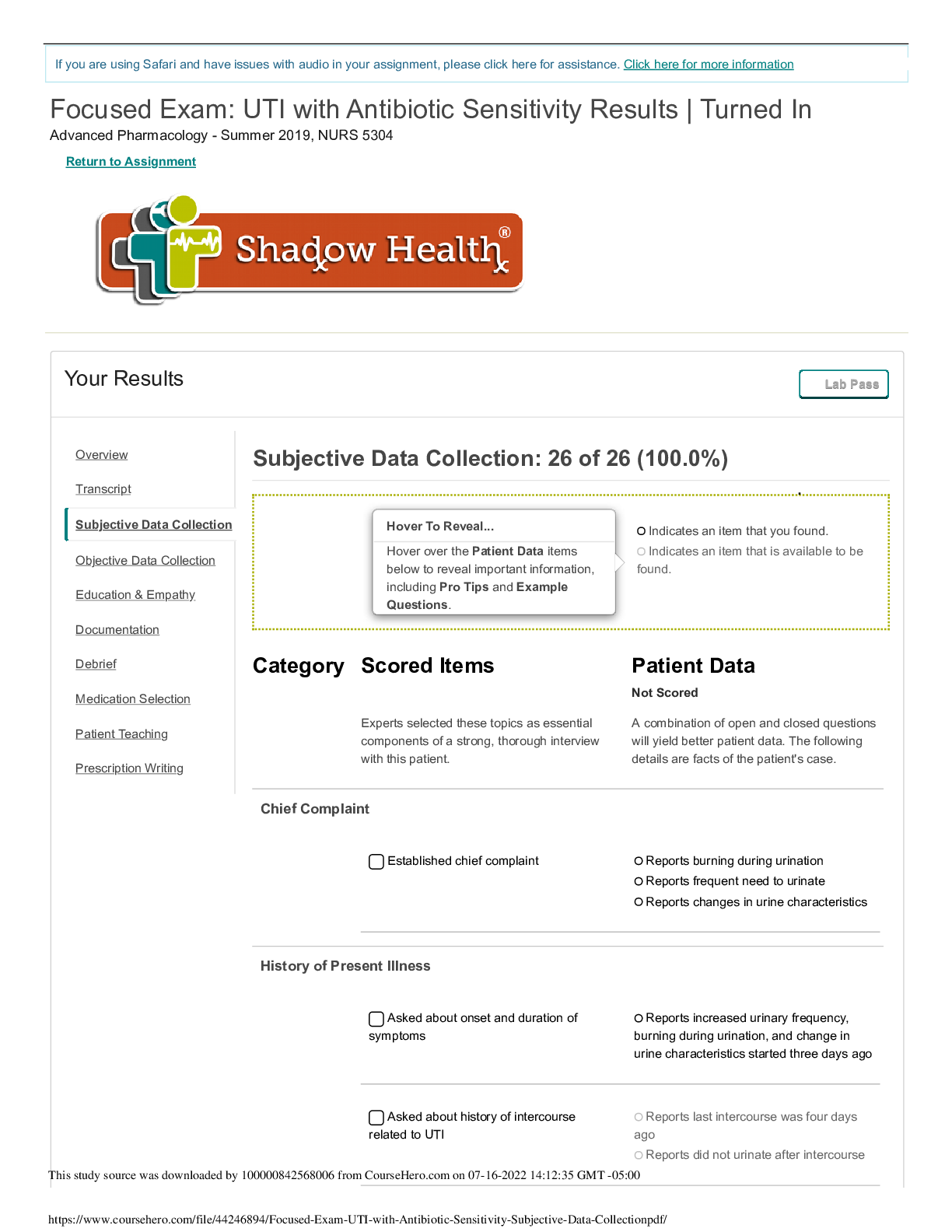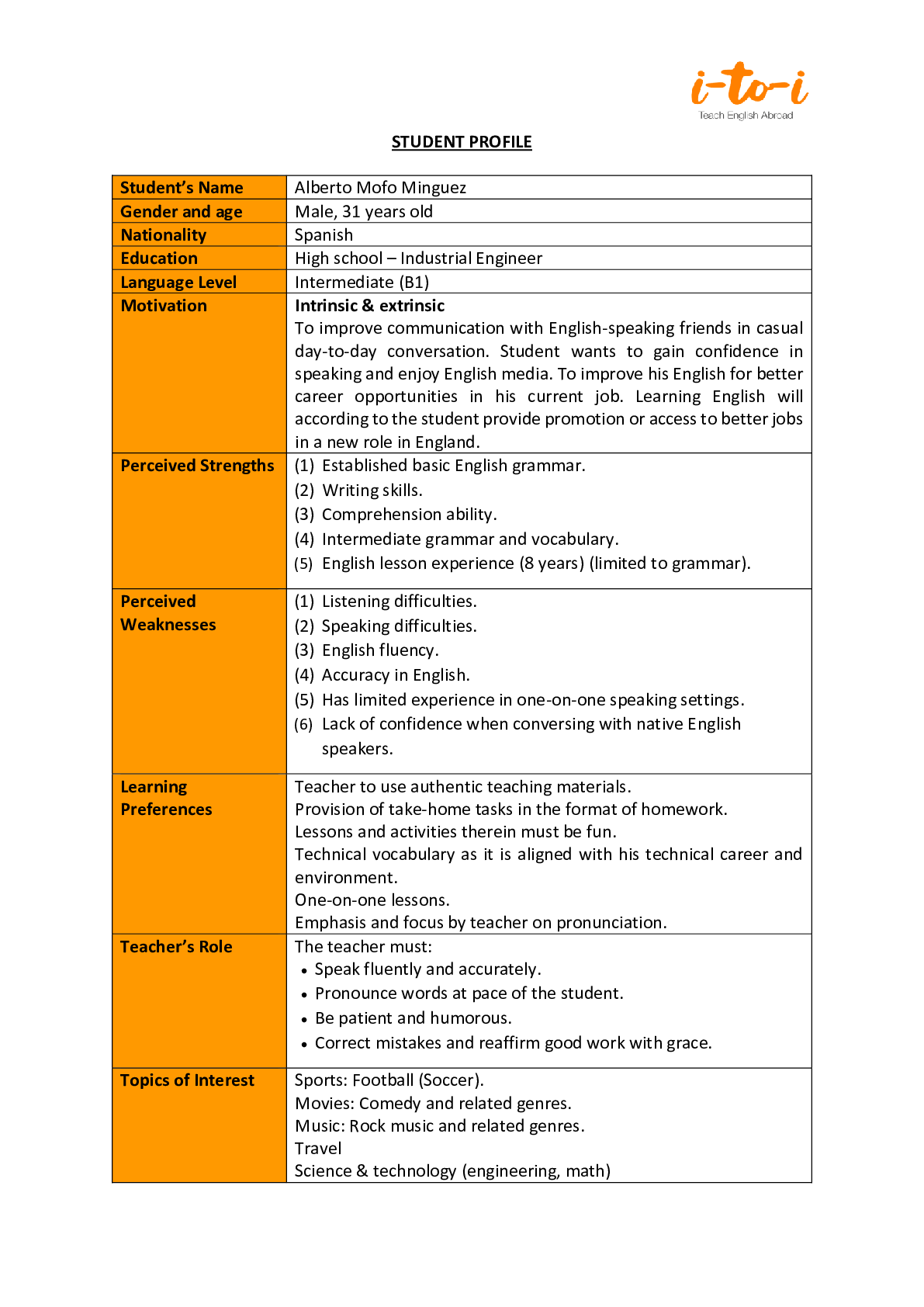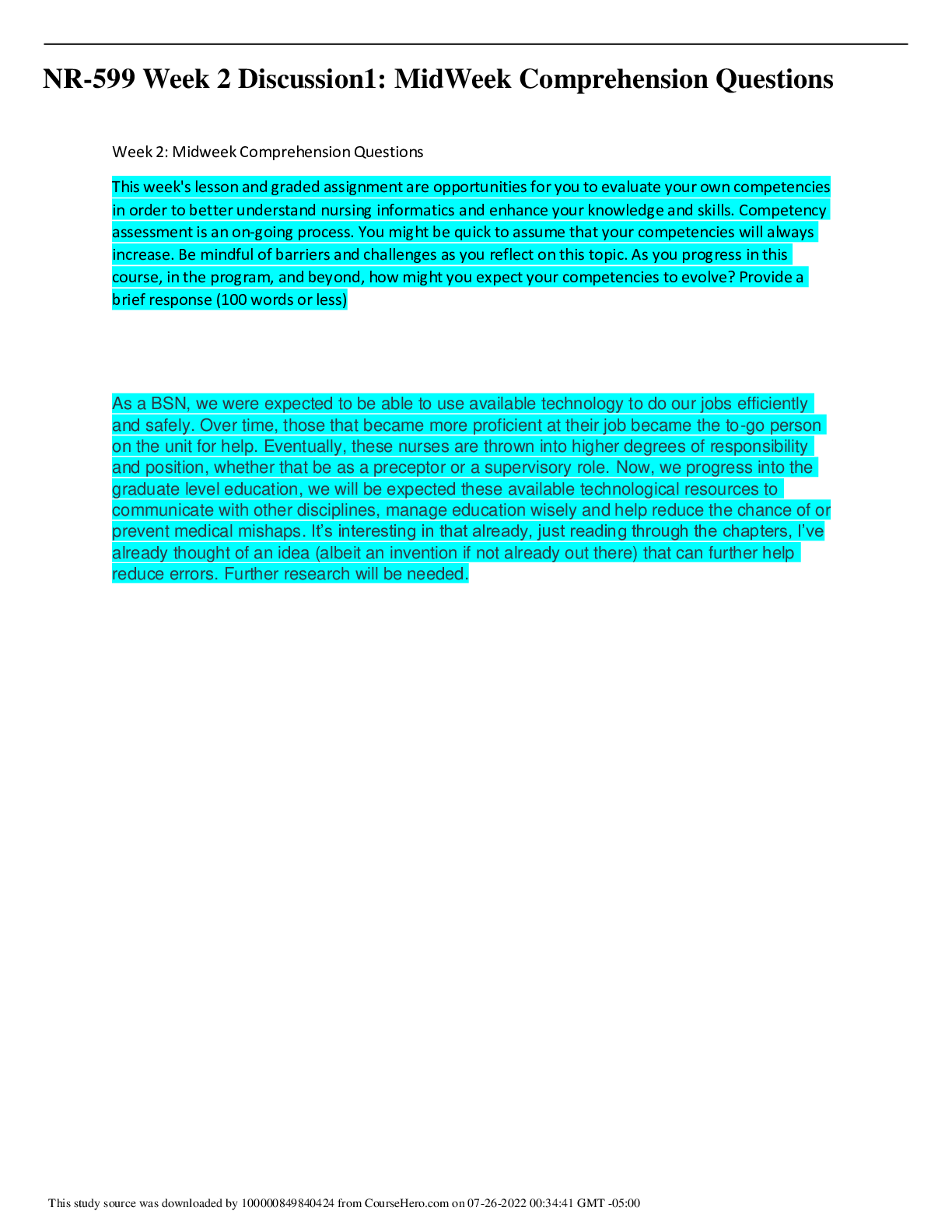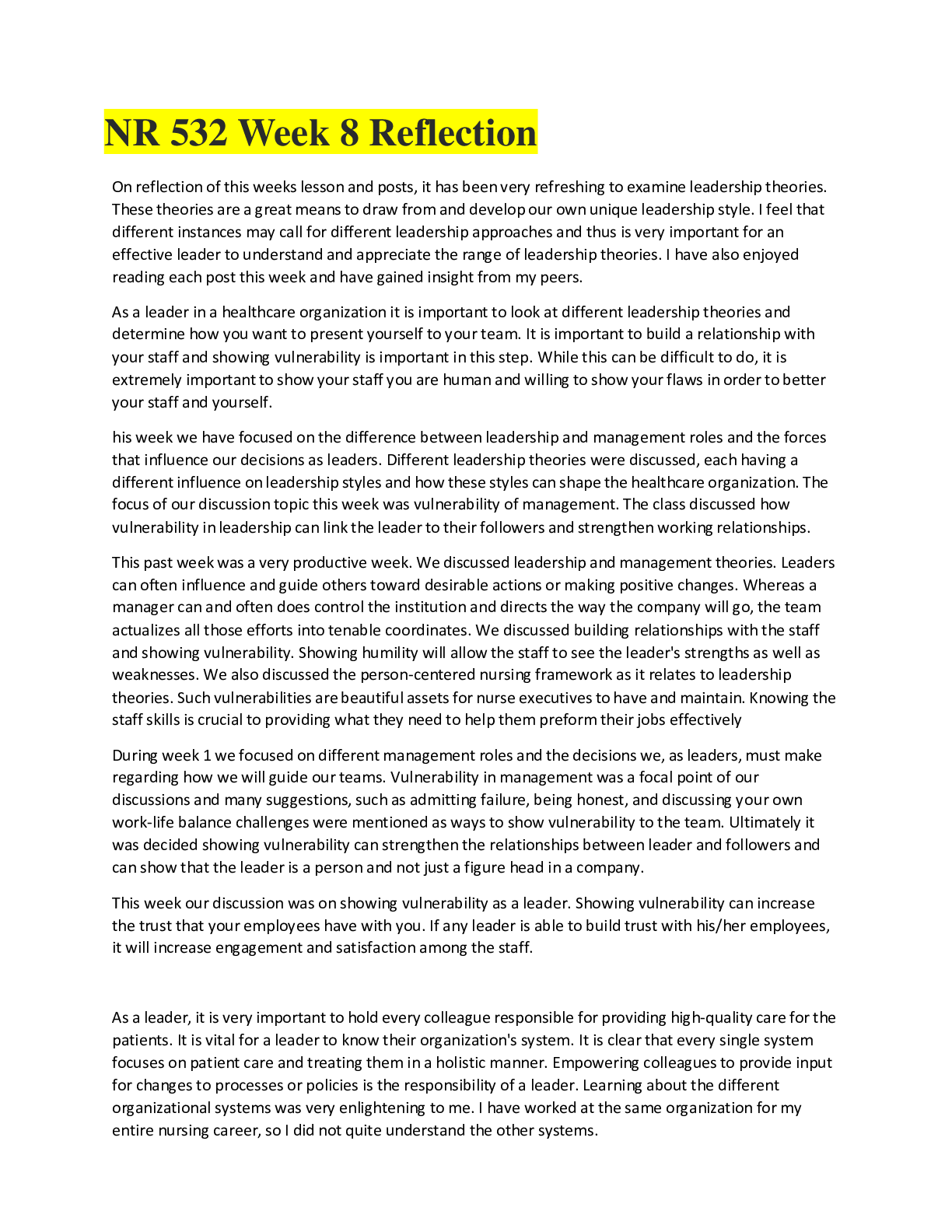NR 511 Midterm Study Guide Worksheet (Spring 2020)
Document Content and Description Below
NR511 Midterm Study Guide Worksheet Disease Risk Subjective Finding Objective Findings Diagnostics Treatment Education GI DISORDERS Appendicitis -Most common between 10-30yrs; but can occur... at any age; rare in infants and older adults -men more at risk - Diets low in fiber, high in fat, refined sugars, & other carbs at increased risk. - Obstruction of appendix is cause of majority of appendicitis - contributing factors: Intra-abdominal tumors, positive family hx - Recent roundworm infection or viral GI infection -Dx made clinically, based primarily on H&P exam - Classic presentation includes acute onset of mild to severe colicky, epigastric, or periumbilical pain - Pain is vague at first then localizes within 24hrs to RLQ - Pain exacerbated by walking\coughing - Men may feel radiated pain in testes - Abd muscle rigidity, N\V, anorexia - Mildly elevated temp 99-100F common - If RLQ accompanied by shaking chills, perforation should be suspected - Older adults may present with weakness, anorexia, abd distention, mild pain leading to delayed dx and increased morbidity. -May have HTN\tachy proportional to pain\symptoms -When lying flat, may flex R knee to relieve tension in abd muscle -Pain with palpation in abd, diffuse in early stages. Localized to RLQ later -Positive for rebound pain; ask pt to cough to localize pain location -Sudden cessation of pain means perforation and is ER -Labs are not diagnostic and nonspecific -Women should have urine human chorionic gonadotrophin to r\o ectopic pregnancy - +Rovsing’s Sign- deep palpation & release in LLQ causes rebound pain in RLQ - +Psoas Sign- lift R leg against gentle pressure causes pain - +Obturator Sign- flex R hip & knee and slowly rotate internally causes pain - +McBurney’s Sign- pain with pressure applied to point between umbilicus & ilium - x-ray\CT helpful when paired with positive H&P findings -Surgical; preoperative care, NPO, correction of fluid\electrolyte imbalances -Avoid narcotics -Atb with 3rd gen cephalosporin; Ex: ampicillin, gentamycin, flagyl -F\U with surgeon -Ambulation after surgery -Adv diet when bowel sounds return -Return to hosp with s\s of infection -Avoid heavy lifting for at least 2 wks Celiac disease ** (autoimmune disorder caused by an immunologic response to gluten) Mostly diagnosed in adulthood. A family member with celiac disease or dermatitis herpetiformis Type 1 diabetes Many asymptomatic. May complain of diarrhea, gas, dyspepsia, wt loss. Atypical symptoms: fatigue, bone or joint pain, arthritis, osteoporosis, or Muscle wasting (anemia), reduces subcutaneous fat, ataxia, & peripheral neuropathy (vitamin B12 deficiencies) osteoporosis or osteopenia (bone loss) Serologic testing for anti-tTG IgA antibody Total IgA (2% of pts have IgA deficiency and will falsely test negative) duodenal biopsies lifelong adherence to a strict gluten-free diet. Referral to a dietician to help. Some pts may need treatment with immunomodulating teaching related to gluten free diet. Some people with celiac disease have vitamin or nutrient deficiencies that do not cause them to feel ill, such as anemia due to iron NR511 Midterm Study Guide Worksheet Down syndrome or Turner syndrome Autoimmune thyroid disease Microscopic colitis (lymphocytic or collagenous colitis) Addison's disease osteopenia (bone loss) liver and biliary tract disorders (transaminitis, fatty liver, primary sclerosing cholangitis, depression or anxiety peripheral neuropathy seizures or migraines missed menstrual periods infertility or recurrent miscarriage canker sores inside the mouth dermatitis herpetiformis (itchy skin rash) hypothyroidism Pts with dermatitis herpetiformis found to have signs of celiac disease on intestinal biopsy. Test for nutritional deficiencies associated with malabsorption of C.D. (hemoglobin, iron, folate, vit B12, Calcium, and Vitamin D.) agents. deficiency or bone loss due to vitamin D deficiency. However, these deficiencies can cause problems over the long term. Untreated celiac/developing certain types of gastrointestinal cancer. This risk can be reduced by eating a gluten-free diet. Cholelithiasis is the formation of gallstones and is found in 90% of patients with cholecystitis. --Risk factors--2 types of stones (cholesterol and pigmented) a. Cholesterol (most common form): female, obesity, pregnancy, increased age, drug- induced (oral contraceptives and clofibrates: cholesterol lowering agent), cystic fibrosis, rapid weight loss, spinal cord injury, Ileal disease with extensive resection, Diabetes mellitus, sickle cell anemia. b. Pigmented: hemolytic diseases, increasing age, hyperalimentation Patient complaint of indigestion, nausea, vomiting (after consuming meal high in fat), and pain in RUG or epigastrium that may radiate to the middle of the back, infrascapular area or right shoulder. Right side involuntary guarding of abdominal muscles, Positive Murphy's sign, possible palpable gallbladder, Low grade fever between 99-101 degrees. Possible jaundice from common bile duct edema and diminished bowel sounds. Mild elevation of WBC up to 15, 000 Abdominal Xray: Quick, noninvasive, reliable, and cost- effective means of identifying the presence of cholelithiasis. a. Initial management-- begins with definitive diagnosis. When asymptomatic (normally an incidental finding while exploring another problem) require no further treatment except teaching s/sx of "gallbladder attack". Nonsurgical candidate can be treated with dissolution therapy or lithotripsy. Acute includes hydration (IV fluids), antibiotics, analgesics, GI rest. b. Treatment of choice for Acute cholecystitis is early surgical intervention after stabilization. Poor surgical risk may benefit from cholecystectomy operatively or percutaneously. Nonsurgical intervention: weight loss, avoidance of fatty foods to decrease attacks, alternative birth control for persons taking oral contraceptives, menopausal women taking estrogen informed about alternative sources of phytoestrogens (soy products). NR511 Midterm Study Guide Worksheet (artificial supply of nutrients, typically IV), cirrhosis, biliary stasis, chronic biliary infections. Crohn’s ** Ages 15-25 of onset and then again at 50-80. Familial tendency, smoker Carcinoma less common in patients with CD due to treatment sometimes colectomy Mild-Four or fewer loose bowel movements per day, can have small amounts of blood and mucus in the stool, and cramping in the rectum. Moderate-4-6 loose bowel movements per day containing more blood and mucus and other sx such as tachycardia, weight loss, fever, mild edema. Severe- frequent bloody bowel movements (6-10), abd pain and tenderness, sx of anemia, hypovolemia, impaired nutrition. Most common sx are abd cramping/tenderness, fever, anorexia, wt loss, spasm, flatulence, RLQ pain or mass Tenderness in LLQ or across entire abd with guarding and abd distension. DRE performed to look for anal and perianal inflammation, rectal tenderness, and blood in stool. S/Sx of peritonitis and ileus may be found depending on severity of crohns. Tender mass in RLQ, anal fissure, perianal fissure, edematous pale skin tags. Extra intestinal finding may be episcleritis, erythema nodosum, nondeforming peripheral arthritis, and axial arthropathy Stool analysis to r/o bacterial, fungal, or parasitic infection for cause of diarrhea. CBC to check for anemia, eval for hypocalcemia, vit D deficiency., hypoalbuminemia, and steatorrhea. LFT to screen for primary sclerosis cholangitis, and other liver problems assoc with IBD. Check fluid and electrolytes. May have elevated WBC count and sed rate and prolonged prothrombin time. Barium upper GI series, colonoscopy, and CT to determine bowel wall thickening or abscess formation Glucocorticoids, there is no cure for CD and treatment is aimed at suppressing inflammation and symptomatic relief of complications. Initially oral prednisone 40-60 mg/d, tapered over 2-4 months, then can have daily maintenance dose of 5-10mg/d. Sulfasalazine for mild to moderate CD 500 mg BID, increased to 3-4 g/d. Clinical improvement in 3-4 wks, and then tapered to 2-3 g/d for 3-6 months, this medication interferes with folid acid absorption and patient must take supplements. Metronidazole effective in tx perianal disease and in controlling crohns colitis, other ABT’s such as Cipro, Ampicillin, and Tetracycline effective in controlling CD ileitis, and ileocolitis. Immunosuppressive meds when unresponsive to other treatments. Pt educated on disease process, diet and lifestyle changes. Stress reduction, adequate rest to decrease bowel motility and promote healing. Low residue diet when obstructive sx present such as canned fruits, vegetables and white bread Diverticulitis ** -Uncommon under 40yrs; risk rises after -Rare in pediatric; equal in men\women -More common in -25% develop symptoms -LLQ abd pain, worsens after eating -Pain sometimes -LLQ abd tenderness with possible Firm, fixed mass may be identified in area of diverticula -Abd x-ray can reveal free air, ileus, obstruction -Barium studies show sinus tracts, fistulas, -Asymptomatic cases managed with high fiber diet or fiber supplement with psyllium -Mild symptoms managed -Increase fiber in diet to avoid constipation and straining -H2O intake of at NR511 Midterm Study Guide Worksheet developed countries -High in low fiber, high fat\red meat diets -Obesity, chronic constipation, h\o diverticulitis, & number of diverticula which occur in sigmoid colon. relieved with BM or flatus -BM may alternate between diarrhea\ constipation -May present with bleeding w\o pain or discomfort -Fever, chills, tachy; LLQ with anorexia, N\V -Fistula may form causing dysuria, pneumaturia, fecaluria -May have rebound tenderness with guarding\rigidity -Tender rectal exam; stool usually + for occult blood obstruction -Colonoscopy to r\o Ca, but less sensitive than barium for diverticula -CT with contrast outpatient with clear liquid diet and rest -Atb should not be routinely used but can be with diverticula abscess culture -Amoxicillin\clavulanate K (or) flagyl with bactrim -Symptoms usually subside quickly and diet can be advanced slowly -Pain managed with antispasmotics Ex; Levsin, Bentyl, BuSpar -Avoid morphine -NG for ileus or intractable N\V -Pt can be D\C’d from hosp once able to maintain adequate nutrition\ hydration if acute phase resolved -Colon resection may be necessary if no improvement or deterioration after 72hrs of treatment least 8\8oz glasses to promote bowel regularity -Bulk-forming laxative may be needed Ex: psyllium, FiberCon, Metamucil GERD ** -Can occur at any age -Risk increases with age, then decreases after 69yrs -Prevalence equal across gender, ethnic, cultural -Obesity, alcohol, caffeinated beverages, chocolate, fruit, decaf coffee, fatty foods, onions, peppermint\ spearmint, tomato products Anticholinergics, beta- -Heartburn; mild to severe -Regurgitation, water brash, dysphagia, sour taste in AM, belching, coughing, odynophagia (painful swallow), hoarseness or wheezing at night -Substernal\ retrosternal pain -Worsens if reclined after eating, eating large meals, constrictive clothing -H&P usually normal -May be + for occult blood in stool -Usually Hx alone diagnoses -May manifest with atypical symptoms such as adult-onset asthma, chronic cough, chronic laryngitis, sore throat, noncardiac chest pain -If pt fails to respond to 4-8wks PPI, EGD is ordered -EGD warranted over empiric treatment when heartburn & -8wk trial of PPI; weight loss, avoiding triggers -If unresponsive to once daily dosing; can increase to twice daily; if no relief EGD needed -PPI and H2-RA should not be taken together -Pt’s on long term therapy should be re-eval’d q6mos -Weight loss, med compliance and avoidance of triggers -Small frequent meals; main meal mid-day, avoid eating 4hrs before bed, avoid straining, sleep with HOB elevated, smoking cessation, stress mgmt NR511 Midterm Study Guide Worksheet adrenergics, CaChannel blockers, diazepam, Estrogen\ progesterone, Nicotine, Theophylline -May present with dysphagia; dysphagia should only occur with first bite dysphagia, bleeding, anemia, weight loss, or recurrent vomiting -EGD with Barrett’s esophagus q3-5yrs Giardia Can harbor in intestine, protozoan attaches to mucosa of small bowel. In US, risk in adults is oral-anal intercourse, children in daycare. In third world countries, risk of contamination through water sources. Bloating, flatulence, nausea, watery diarrhea, weight loss, anorexia, Malabsorption Stool testing positive for trophozoites 50% of the time. Duodenal aspirate or small bowel biopsy Quinacrine Hydrochloride (Atabrine) 100 mg TID after meals for 5-7 days or Metronidazole (Flagyl) 250 mg TID for 5-7 days Teach good hand washing technique, sanitize surfaces, and avoid swimming in all types of water sources to avoid further contamination. H. Pylori Infection Risks: Increased age, living in crowded conditions, no clean water source (nonfiltered water), smoking Ache or burning pain in abdomen. Abdominal pain that is worse when stomach is empty. Nausea/loss of appetite/unintentional weight loss. Frequent burping/bloating Objective Findings RUQ/LUQ tenderness -Fecal antigen assay -Urea breath Test -Biopsy with histological examination -Serological antibody [Show More]
Last updated: 1 year ago
Preview 1 out of 111 pages
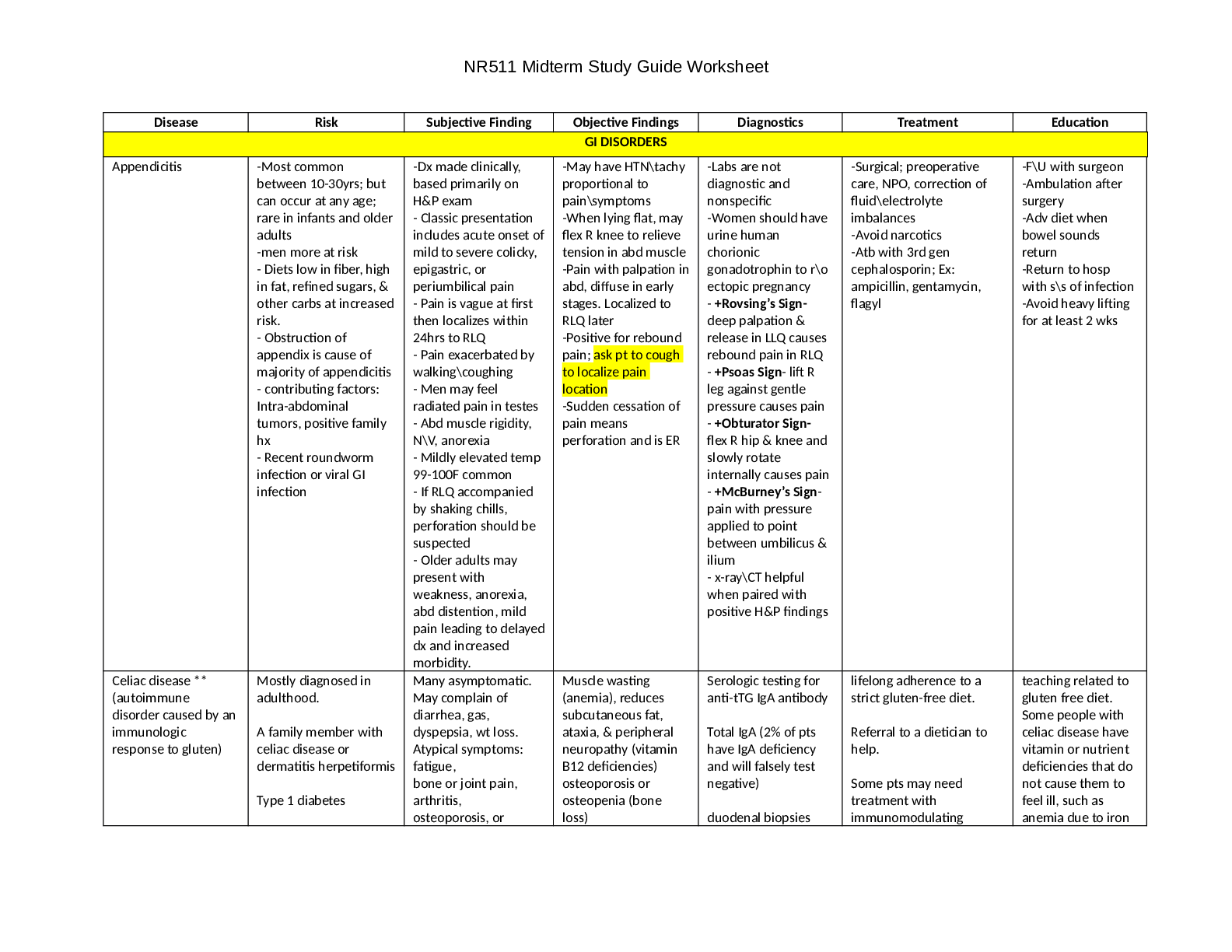
Reviews( 0 )
Document information
Connected school, study & course
About the document
Uploaded On
Sep 22, 2021
Number of pages
111
Written in
Additional information
This document has been written for:
Uploaded
Sep 22, 2021
Downloads
0
Views
70

